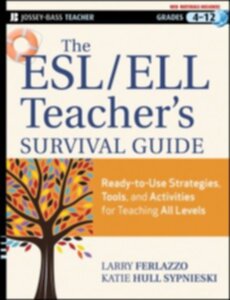Seven Tips for Connecting with ELLS
In their book, The ESL / ELL Teacher’s Survival Guide: Ready-to-Use Strategies, Tools, and Activities for Teaching English Language Learners of All Levels, published by Jossey-Bass, Larry Ferlazzo and Katie Hull Sypnieski, provide concrete tips for connecting with ELL students.

Here the top seven tips they offer:
1. Have regular check-ins with your students. You can check in with a few students each day. Ask them what’s going on in their lives, how their families are doing, any plans they have for the weekend. These simple questions help build an authentic relationship and helps students feel like they have a teacher who is really interested in their lives.
2. Read student writing. Read what your students write. And, even more importantly, take the time to make notes on their writing. You can learn a lot by asking them to pen regular reflections and learning about their feelings, concerns, and successes.
3. Write About Your Classroom. Many of you already write about your classroom experiences and may even blog about them. Share your writing and thoughts with your ELL students. This helps make students feel valued. As Ferlazzo wrote in a recent post, “This can be powerful on a number of levels, but in terms of relationship building, it shows students that the teacher thinks about them outside of the classroom. Taking a few minutes to write about the class (whether it is a simple reflection on how a lesson went, how a student demonstrated an exceptional insight, or sharing a few successes and challenges from the week) and then sharing this writing with the class can increase trust and respect between the teacher and the students.”
4. The Teacher/Student Letter Exchange. It’s important to share who you are and where you’re coming from with your students. During the first week of school, it’s a good idea to write a short letter to the class. Let them know where you’re from, where you grew up, and what you expect from the class. This letter is a model for students so they, in turn, can write back to you.
5. Have Weekly Reflections. Ask your students to write a weekly reflection. This could be a journal entry or your students’ responses to questions you post to them. You could give them a journal prompt such as what was their favorite activity in the classroom for that week or what are they doing this coming weekend. These reflections also become talking points in class to help create a bond with your students.
6. The Evaluation. Ask your students to anonymously evaluate you and your teaching. Ask them to be respectful but honest in a constructive way.
7. Walk the Talk. Sometimes it’s not easy to build relationships with your students inside the classroom so it can be a good idea to take a five-minute walk around campus and listen to your students. Ask them what’s on their mind, what they would like to hear about, and how things are going.
For addition quality bilingual and bicultural books for ELL students and parents, visit:
www.Lecturabooks.com
